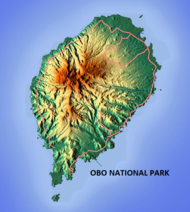Sao Tome Island
Geography

São Tomé Island is about 48 kilometres (30 miles) long (north-south) by 32 kilometres (20 miles) wide (east-west). It rises to 2,024 metres (6,640 feet) at Pico de São Tomé and includes the capital city, São Tomé, on the northeast coast. The nearest city on mainland Africa is the port city of Port Gentil in Gabon located 240 kilometres (150 miles) to the east.
The island is surrounded by a number of small islands, including Ilhéu das Rolas, Ilhéu das Cabras and Ilhéu Gabado.
Languages
The main language is Portuguese, but there are many speakers of Forro and Angolar (Ngola), two Portuguese-based creole languages. The name "São Tomé" is Portuguese for Saint Thomas.
Geology
The entire island of São Tomé is a massive shield volcano that rises from the floor of the Atlantic Ocean, over 3,000 m (10,000 ft) below sea level. It formed along the Cameroon line, a line of volcanoes extending from Cameroon southwest into the Atlantic Ocean. Most of the lava erupted on São Tomé over the last million years has been basalt. The youngest dated rock on the island is about 100,000 years old, but numerous more recent cinder cones are found on the southeast side of the island.
Environment and economy
The higher slopes of the island are forested and form part of the Parque Natural Obô de São Tomé, but agriculture is important near the north and east coasts. The chief exports are cocoa, coffee, copra, and palm products, while there is also a fishing industry.
Large reserves of oil are in the ocean between Nigeria and São Tomé. The discovery has been lamented by some as endangering the nation's political stability and natural environment. In response to these concerns the government of São Tomé and Príncipe has drawn up legislation in an attempt to ensure the efficient and equitable use of oil revenues over time.
Natural history
Birds
The island has a total of 63 regular bird species, plus an additional 36 vagrant and unconfirmed species. Of these, 19 are endemic and 3 near endemic; in addition, the local subspecies of olive ibis (Bostrychia olivacea bocagei) and maroon pigeon (Columba thomensis) are endemic and considered critically endangered. Six species are considered vulnerable, and two critically endangered (São Tomé fiscal and São Tomé grosbeak).
Administrative divisions
São Tomé is divided into the following six districts (seat within brackets):
- Água Grande (São Tomé)
- Cantagalo (Santana)
- Caué (São João dos Angolares)
- Lembá (Neves)
- Lobata (Guadalupe)
- Mé-Zóchi (Trindade)
Towns and villages
Villages on the island include:
- Agua-Coco
- Agua Ize
- Alice
- Alto Douro
- Andrade
- Bela Vista
- Blublu
- Bom Successo
- Buenos Aires
- Dona Augusta
- Dona Eugenia
- Enjale
- Formiga
- General Fonseco
- Graça
- Granja
- Guadalupe
- Guegue Norte
- Henrique
- Java
- Lemos
- Mbombo
- Mbondi
- Monte Café
- Monte Herminios
- Monte Rosa
- Neves
- Nova Olinda
- Nzumbi
- Plato Café
- Ponta Figo
- Portinho
- Porto Alegre
- Preserverança
- Quimpo
- Ribeira Afonso
- Santa Catarina
- Santa Clotilde
- Santa Cruz
- Santa Josefina
- Santana
- Santo António
- São João dos Angolares
- São José
- São Tomé
- Saudade
- Trindade
- Ubabundo
-
São Tomé Island
-
São Sebastião Lighthouse
-
Boca do Inferno, São Tomé
-
Pico Cão Grande, São Tomé Island
-
Fauna in Lobata District, São Tomé
-
Cacao production in São Tomé
-
Igreja de Nossa Senhora de Guadalupe, in Guadalupe, São Tomé Island.
-
Lagoa Azul, STP
-
One of the traditional Roças in São Tomé and Príncipe
-
Cocoa beans drying, São Tomé
-
Shrimp and French fries as served in a local hotel, São Tomé
-
Guadalupe, São Tomé
-
Sea turtle as seen in São Tomé Island
-
Municipal market of São Tomé City
References
- ^ "African Bird Club – São Tomé e Príncipe". Archived from the original on 2012-05-28. Retrieved 2008-01-26.
- ^ "Maroon Pigeon (Columba thomensis)". Archived from the original on 2021-10-24. Retrieved 2020-12-04.














